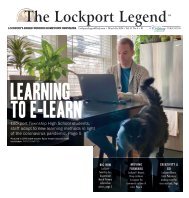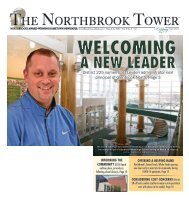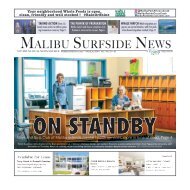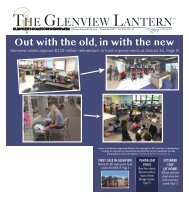WB_041819
You also want an ePaper? Increase the reach of your titles
YUMPU automatically turns print PDFs into web optimized ePapers that Google loves.
28 | April 18, 2019 | The wilmette beacon SOUND OFF<br />
wilmettebeacon.com<br />
A Word From The (Former) President<br />
Posted to WilmetteBeaconDaily.com 2 days ago<br />
Some thoughts on the recent election<br />
John Jacoby<br />
Contributing Columnist<br />
Next month, 23<br />
newly-elected officials<br />
will replace<br />
an equal number of officials<br />
whose terms have<br />
come to an end. The new<br />
officials are to be congratulated,<br />
but just as important,<br />
the retiring officials<br />
deserve our thanks for<br />
their many years of public<br />
service. They’ve donated<br />
their time and considerable<br />
talents to make local<br />
government effective and<br />
responsive. We’re fortunate<br />
to have been served<br />
by these highly competent<br />
and dedicated officials:<br />
• Wilmette Village<br />
Board: Julie Wolf and<br />
George Pearce<br />
• Kenilworth Village<br />
Board: James McClamroch,<br />
Jr.<br />
• Wilmette School<br />
District 39: Tracy Kearney<br />
and Alice Schaff<br />
• Kenilworth School<br />
District 39: Melinda<br />
Kelly, Danielle Boros,<br />
Donna Keller, and Scott<br />
Wallace<br />
• Avoca School District<br />
37: Joel Raynes and<br />
Sheryl Swibel<br />
• Wilmette Park<br />
District: Shelley Shelly,<br />
Stephanie Foster, John<br />
Olvany , and Ryrie Pellaton<br />
• Kenilworth Park District:<br />
Heidi Higgins<br />
• Wilmette Library District:<br />
Kathleen O’Laughlin<br />
and Virginia George<br />
• Kenilworth Library<br />
District: Elizabeth Cittadine,<br />
Jennifer Davidson,<br />
and Debbie Zelten<br />
• New Trier District 203:<br />
Lori Goldstein and Patrick<br />
O’Donoghue<br />
Ideally, large numbers<br />
of informed citizens would<br />
turn out to elect the local<br />
officials who collectively<br />
decide, among other<br />
important issues, how to<br />
spend more than 85% of<br />
each homeowner’s annual<br />
property taxes. But history<br />
shows that this isn’t the<br />
case. In Wilmette, the turnout<br />
this year was 17.24%<br />
of registered voters, and in<br />
Kenilworth, only 8.59%<br />
went to the polls. (These<br />
numbers may be somewhat<br />
below the actual turnout,<br />
because some “registered<br />
voters” may no longer live<br />
in the jurisdiction.)<br />
By comparison, in the<br />
City of Chicago, turnout<br />
this year was 32.96%; in<br />
suburban Cook County,<br />
it was 14%; in Winnetka,<br />
it was 32.65%; in Northfield,<br />
it was 15.9%; in<br />
Glencoe, it was 5.22%;<br />
and in Glenview, it was<br />
8.59%. There’s nothing to<br />
brag about in any of these<br />
numbers, but not surprisingly,<br />
turnout was higher<br />
in places with contested<br />
elections (like Chicago,<br />
Wilmette, and Northfield)<br />
and in places with important<br />
referenda (like the<br />
Winnetka school district’s<br />
proposal to issue bonds for<br />
a $90.6 million building<br />
program).<br />
While disappointing,<br />
it’s also understandable<br />
why turnout is low. Why<br />
vote when all or most of<br />
the races are uncontested?<br />
Why vote when you have<br />
no major complaints about<br />
the way local government<br />
is functioning? Why<br />
vote when the available<br />
information about candidates<br />
is limited and doesn’t<br />
clearly reveal their policy<br />
differences? And how<br />
can we expect citizens to<br />
be informed about and<br />
interested in all six of the<br />
units of local government<br />
that appear on the ballot?<br />
It’s far easier to leave elections<br />
in the hands of voters<br />
with a particular interest<br />
and knowledge, and hope<br />
that everything turns out<br />
okay, than it is to become<br />
familiar with, for example,<br />
the issues facing Oakton<br />
Community College and<br />
the policy positions of the<br />
thirteen candidates running<br />
for its Board of Trustees.<br />
There may be ways to<br />
stir up interest in local<br />
elections, and I wish some<br />
civic-minded group(s)<br />
would look into this,<br />
because widespread participation<br />
in the political<br />
process is the best way to<br />
assure the continuation of<br />
effective and responsive<br />
local government.<br />
On a related subject, I’m<br />
told that one issue raised<br />
by Wilmette residents<br />
during the recent election<br />
campaign is the large number<br />
of potholes on streets<br />
and alleys. These residents<br />
are correct. This winter’s<br />
severe freeze/thaw cycle<br />
was especially damaging.<br />
The Village received more<br />
than twice the number of<br />
pothole complaints this<br />
year (January through<br />
March) than last year and<br />
has already repaired 50%<br />
more potholes this year<br />
than last. Crews will be<br />
working as long as necessary<br />
to repair the rest, and<br />
you’re encouraged to call<br />
and report potholes that<br />
haven’t been addressed.<br />
Long term, the Village will<br />
probably have to spend<br />
more to maintain streets<br />
and alleys in a condition<br />
that meets the standards of<br />
the community.<br />
Letters to Editor<br />
Winners of contest thank<br />
Beacon, Depot Nuevo<br />
We want to thank you<br />
for the contest prize, which<br />
you made possible, in your<br />
pre-Valentine Wilmette<br />
Beacon newspaper column<br />
on the subject of “How We<br />
Met.”<br />
We finally were able to<br />
use the $50 gift certificate<br />
at the Depot Nuevo restaurant<br />
this past Saturday.<br />
April 6. The restaurant<br />
staff was most gracious<br />
and courteous, considering<br />
how hopping busy the establishment<br />
was that evening.<br />
The dinner was excellent<br />
with large portions<br />
for my wife and I.<br />
The restaurant was an<br />
Excellent choice for a<br />
“War Of The Roses,” feuding<br />
couple that agreed to a<br />
truce, that evening, over a<br />
good meal with a colorful<br />
atmosphere. Kudos to you<br />
and your staff. With much<br />
gratitude and appreciation,<br />
your Wilmette Beacon<br />
reader fan.<br />
Anastasios J. Vasilatos<br />
Wilmette residenta<br />
Planting trees can reduce<br />
stormwater runoff<br />
How can municipalities<br />
reduce storm water<br />
runoff? Some increase the<br />
size of underground pipes<br />
and holding tanks, and<br />
spend millions of dollars.<br />
Others consider greener<br />
and cheaper solutions in<br />
concert with the grey infrastructure<br />
of pipes and<br />
holding tanks.<br />
One of the cheapest<br />
green solutions is to plant<br />
large canopy trees. USDA<br />
Forest Service research<br />
shows that large trees reduce<br />
storm water runoff<br />
by acting like large umbrellas<br />
that intercept the<br />
evaporating rainfall in<br />
their canopies. A large oak<br />
or cottonwood canopy tree<br />
can intercept 3,000 gallons<br />
annually.<br />
Wilmette’s storm water<br />
plan excludes planting<br />
large canopy trees.<br />
Even worse, Wilmette’s<br />
storm water plan includes<br />
destroying Community<br />
Playfield’s grove of large<br />
canopy cottonwood trees.<br />
Wilmette residents cannot<br />
allow this senseless and<br />
unnecessary destruction.<br />
Cottonwoods were important<br />
to Wilmette’s Native<br />
Americans who used<br />
the trunks for dugout canoes,<br />
the bark as forage<br />
for horses and medicinal<br />
tea for humans, and the<br />
sweet sprouts and inner<br />
bark as food. They turned<br />
the trees into trail markers<br />
and used them as meeting<br />
places. Native Americans<br />
and early European settlers<br />
knew that a Cottonwood<br />
in a sweltering prairie indicated<br />
a welcome water<br />
source.<br />
These Cottonwoods<br />
flourished for about a century<br />
in Community Playfield<br />
because they love its<br />
sun and marshy moisture.<br />
Native to Wilmette, these<br />
versatile trees tolerate<br />
soils ranging from welldrained<br />
to wet, dry, alkaline<br />
or clay, and drought<br />
and flooding. The site’s<br />
Cottonwoods provide Wilmette’s<br />
small mammals,<br />
woodpeckers, songbirds,<br />
and butterflies with vital<br />
and irreplaceable food and<br />
habitat. Cottonwoods are<br />
favorite Baltimore oriole<br />
nesting sites. And they<br />
host 368 species of Lepidoptera,<br />
including spring’s<br />
first butterfly, the Mourning<br />
Cloak whose large velvety<br />
maroon wings have<br />
bright blue dots and yellow<br />
edges.<br />
Following a winter of<br />
hibernating in logs or<br />
tree bark, adult Mourning<br />
Cloak butterflies emerge<br />
in spring and mate. The<br />
females lay clusters of<br />
pale yellow eggs on tree<br />
twigs which produce white<br />
speckled, black, bristly<br />
caterpillars that eat the<br />
host tree’s leaves and then<br />
pupate. The emerging<br />
adult butterflies will spend<br />
the coming winter hibernating<br />
until the following<br />
spring. A primary Mourning<br />
Cloak butterfly tree for<br />
all these activities is the<br />
Cottonwood.<br />
Wilmette is spending<br />
millions of dollars to cre-<br />
Please see Letters, 29


















